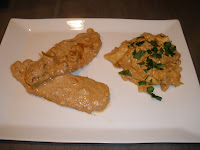Because of the Magyars’ nomadic lifestyle, they depended on their livestock as a primary source of food, which is why meat is so prevalent in many Hungarian dishes. The Turks introduced paprika into Hungarian cuisine. Hungarians learned to use garlic, onion, nutmeg, and fruits in their cuisine as a result of Western influence. Other common ingredients found in Hungarian cuisine include sour cream, walnuts and hazelnuts, smoked bacon, cabbage, tomatoes, dumplings, butter, eggs, vinegar, and pickled vegetables.
Lunch is the largest meal of the day, and typically includes an appetizer, soup, main entrée of meat served with a salad, and dessert. Sometimes, fruit may be served after dessert. This week, I prepared one large feast based on this progression. In all honestly, I’m not sure how anyone could successfully host such an elaborate lunch on a consistent basis. I worked on this single meal periodically for two days. Thankfully, we enjoyed it and even relished in its incredible flavors!
Appetizer: Savory Crepe filled with Veal, or Hortobágyi palacsinta
The actual translation for this dish is Pancakes of the Hortobagyi, a group of people living in the Hortobagy region of Hungary. I found conflicting information regarding its origins. Some claim that its origin is in the Hortobagy region, while others state that this famous dish’s invention is attributed to the 1958 Brussels World Fair and does not originate from Hortobagy at all. Either way, the dish is delicious.
In Hungary, pancakes are served exclusively as desserts, not as breakfast. The only exception to the dessert rule is the savory Hortobagyi palacsinta, a crepe stuffed with stewed veal, onions, and tomatoes. Hot paprika, salt, and pepper season the meat. After stewing the meat, onions, and tomatoes, the liquid is drained and mixed with flour and sour cream to create a cream sauce for the crepe. My guests laughed that this meaty dish was only the opening dish for our Hungarian meal, but we all agreed that it was a great way to start the meal.
Soup: Chilled Sour Cherry Soup
Interestingly, my American cookbooks include this in “Desserts” chapters although Hungarians clearly serve this as part of a traditional soup course. While researching Hungarian cuisine, I found June Meyer’s Authentic Hungarian Heirloom Recipes website to be a great source of information, and I turned to it for a traditional Sour Cherry Soup recipe. The combination is primarily flavored with sour cherries, sour cream, and sugar. I found other variations including the addition of red wine, cinnamon, and cloves, but I opted with the basic traditional recipe. The soup is surprisingly light, and it served as a great transition dish between the veal crepes and the next course of Chicken Paprikas.
Because I used Hot Paprika for flavoring in the crepes, I opted to make chicken paprikas with mild, sweet Hungarian paprika. The dish includes chicken cutlets served in a sauce of sour cream, paprika, and onion. (Sound familiar?) In most recipes for chicken paprikas, the notes stated to serve the dish with dumplings tossed in the sauce, so I followed those guidelines and made spaetzle (much more successfully than I did in my week of German cuisine) to toss in the cream sauce.
Serving a simple salad with meat is an imperative in Hungarian cuisine and tradition. One simple salad that consistently reappeared as I reviewed Hungarian salads is Cucumber Salad with Sour Cream. I chose June Meyer’s recipe, which includes a simple dressing of garlic, vinegar, sugar, salt, black pepper, and sour cream. I was surprised at how well this salad complemented the chicken paprikas. Even with its inclusion of sour cream, it provided a surprisingly light and refreshing escape from the heavier paprika cream sauce.
Dessert: Chocolate Orange Dobostorte
Without a doubt, this is my greatest dessert triumphant during my project. The Dobostorte is named for its inventor, a well-known Hungarian pastry chef named Jozsef C Dobos. The cake includes multiple layers of sponge cake and chocolate buttercream topped with a single layer of caramel. A unique element is the layer of caramel atop the cake, which was added as a strategy to seal the cake so that it maintained its moist layers.
For my presentation, I turned to my favorite yellow Gourmet Cookbook and crafted a Chocolate Orange Dobostorte, which included an orange glaze of melted orange marmalade and Grand Marnier to moisten each layer of sponge cake. This cake is definitely deserving of its reputation for being served at special occasions…in part because its layers are so rich and luscious, but also because of the four-hour timeline from start to finish for the entire endeavor.
Despite the fact that I served only one Hungarian meal this week, I am confident that its complexities taught me more about the style of cuisine than I’ve learned in other weeks with several small menus. We enjoyed every dish, and even as I write this blog posting, I’m craving that sauce of paprika, sour cream, and onion. The good news is that we have two leftover pieces of dobostorte waiting in the refrigerator for tonight’s dessert.






No comments:
Post a Comment